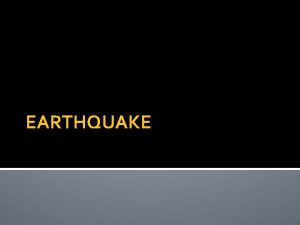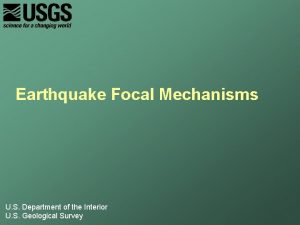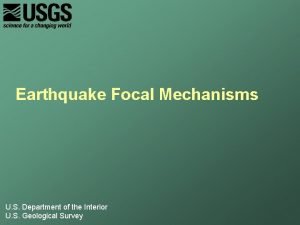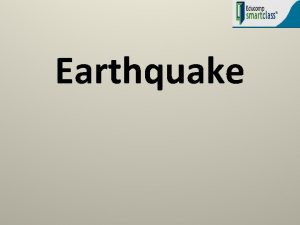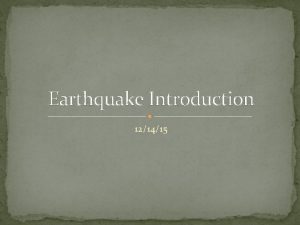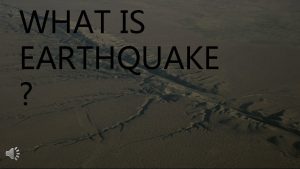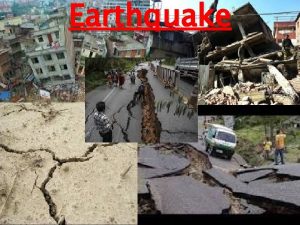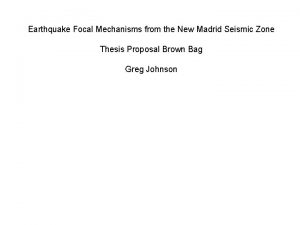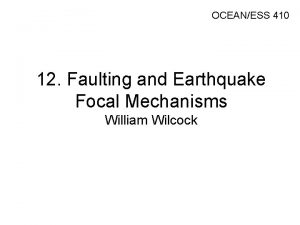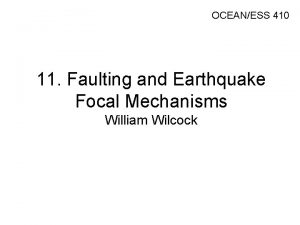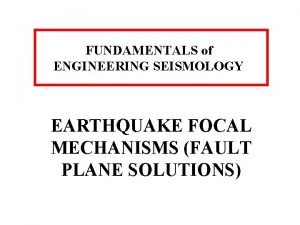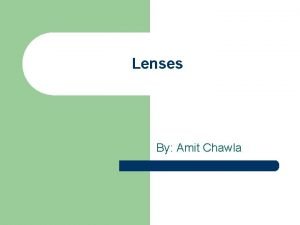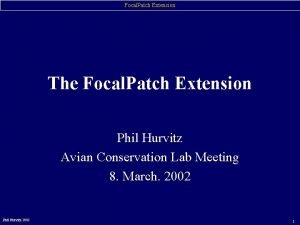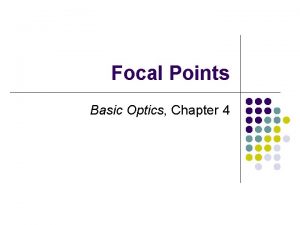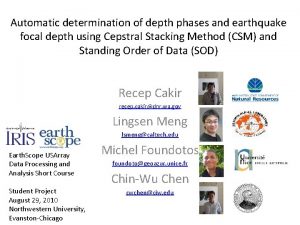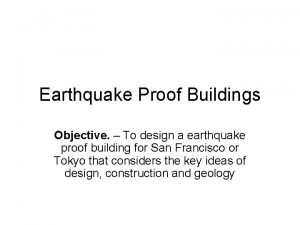Earthquake Focal Mechanisms U S Department of the





























- Slides: 29

Earthquake Focal Mechanisms U. S. Department of the Interior U. S. Geological Survey

Focal Mechanism Solutions § § § Also called “beachball diagrams” “fault plane solutions” Tell us the geometry and mechanism of the fault in a simple diagram Generally reconstructed from waveform data derived from the moment tensor (which is more general), but originally calculated using first motions – done here to illustrate the concepts

Examples USGS

Two steps to understanding 1) The stereographic projection 2) The geometry of first motions and how this is used to define fault motion. http: //www. uwsp. edu/geo/projects/geoweb/participants/dutch/STRUCTGE/sphproj. htm

Stereographic projection § § A method of projecting half a sphere onto a circle. e. g. planes cutting vertically through the sphere plot as straight lines Images from http: //www. learninggeoscience. net/free/00071/index. html

Stereonets § A template called a stereonet is used to plot data. § Example – plotting planes (e. g. faults) USGS

Stereonets § Example – plotting lines (e. g. ray paths) USGS

Stereonets § Example – pitch (or rake) of a line on a plane (e. g. the slip direction on a fault) USGS

Refresher on terminology § Slip angle is measured from horizontal (positive for thrusts) USGS

Energy and Polarity of “First Motions” Cox and Hart. Plate Tectonics – How it works.

Earthquake on a vertical plane Edited from Cox and Hart. Plate Tectonics – How it works.

Determination of nodal planes Cox and Hart. Plate Tectonics – How it works.

Spreading of the seismic wave Cox and Hart. Plate Tectonics – How it works.

Data on the surface, interpreted in 3 D Cox and Hart. Plate Tectonics – How it works.

Take-off angle § The angle (from vertical) that the ray leaves the earthquake = take-off angle Stein and Wysession, An Introduction to seismology, earthquakes and Earth structure

Azimuth (f) and take-off angle USGS Stein and Wysession, An Introduction to seismology, earthquakes and Earth structure

With a lot of recordings we can reconstruct faults with any orientations Cox and Hart. Plate Tectonics – How it works.

Fault types and “Beach Ball” plots USGS

Example Focal mechanism diagrams on midocean ridges Stein and Wysession, An Introduction to seismology, earthquakes and Earth structure

Same N-S fault, different slip direction Stein and Wysession, An Introduction to seismology, earthquakes and Earth structure

Great review on the web at: http: //www. learninggeoscience. net/free/00071/

Waveform modeling § By constructing synthetic seismograms and comparing them to the recorded data we use more of the information in the seismogram, not just the arrival time and first motion data Stein and Wysession, “An Introduction to seismology, earthquakes and Earth structure”

Waveform modeling Construction of the synthetic seismogram Stein and Wysession, “An Introduction to seismology, earthquakes and Earth structure” u(t) = x(t) * e(t) * q(t) * i(t) U(ω)= X(ω) E(ω) Q(ω) I(ω) source time function seismogram attenuation reflections & conversions at interfaces instrument response

Source-time function Slip rate At one point on the fault slip takes a finite time (called “rise time”): Slip § Time = rupture Fault TD Time The slip travels along the fault at rupture velocity vr, so there is also a finite “rupture time” Slip rate § TD Map view TR Time

Source time function TD § * = Time TR Slip rate Time Slip rate The source time function is the combination of the rise time and the rupture time: Slip rate § TR TD Directionality affects the rupture time TR TR TD TD Rupture direction TR TR TD TD

phase reflections § § e(t) represents reflections due to the Earth structure If modeling only the P arrival, it’s only needed for shallow events Stein and Wysession, “An Introduction to seismology, earthquakes and Earth structure”

Attenuation § The loss of energy with time A(t) = A 0 e -ω0 t/2 Q § Q controls the amount of loss Sipkin and Jordan 1979, copywrite Seismological Society of America

Instrument response function Stein and Wysession, “An Introduction to seismology, earthquakes and Earth structure” § The response of the seismometer is different for different frequencies so it also filters the data.

Moment Tensor Inversion § § The Moment tensor describes the fault as set of equivalent forces Calculated from the amplitude of surface Love Rayleigh waves USGS Stein and Wysession, “An Introduction to seismology, earthquakes and Earth structure”
 Sơ đồ cơ thể người
Sơ đồ cơ thể người Số nguyên tố là
Số nguyên tố là Tư thế ngồi viết
Tư thế ngồi viết Cong thức tính động năng
Cong thức tính động năng Tỉ lệ cơ thể trẻ em
Tỉ lệ cơ thể trẻ em đặc điểm cơ thể của người tối cổ
đặc điểm cơ thể của người tối cổ Các châu lục và đại dương trên thế giới
Các châu lục và đại dương trên thế giới Phản ứng thế ankan
Phản ứng thế ankan ưu thế lai là gì
ưu thế lai là gì Thẻ vin
Thẻ vin Môn thể thao bắt đầu bằng từ chạy
Môn thể thao bắt đầu bằng từ chạy Cái miệng nó xinh thế
Cái miệng nó xinh thế Hát kết hợp bộ gõ cơ thể
Hát kết hợp bộ gõ cơ thể Từ ngữ thể hiện lòng nhân hậu
Từ ngữ thể hiện lòng nhân hậu Trời xanh đây là của chúng ta thể thơ
Trời xanh đây là của chúng ta thể thơ Tư thế ngồi viết
Tư thế ngồi viết Gấu đi như thế nào
Gấu đi như thế nào V. c c
V. c c Thể thơ truyền thống
Thể thơ truyền thống Khi nào hổ con có thể sống độc lập
Khi nào hổ con có thể sống độc lập đại từ thay thế
đại từ thay thế Thế nào là hệ số cao nhất
Thế nào là hệ số cao nhất Diễn thế sinh thái là
Diễn thế sinh thái là Vẽ hình chiếu vuông góc của vật thể sau
Vẽ hình chiếu vuông góc của vật thể sau Lp html
Lp html Thế nào là mạng điện lắp đặt kiểu nổi
Thế nào là mạng điện lắp đặt kiểu nổi Mật thư anh em như thể tay chân
Mật thư anh em như thể tay chân Lời thề hippocrates
Lời thề hippocrates Chụp tư thế worms-breton
Chụp tư thế worms-breton Vẽ hình chiếu đứng bằng cạnh của vật thể
Vẽ hình chiếu đứng bằng cạnh của vật thể






























